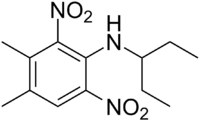Pendimethalin
 | |
| Names | |
|---|---|
| IUPAC name
3,4-Dimethyl-2,6-dinitro-N-pentan-3-yl-aniline | |
| Identifiers | |
| 40487-42-1 | |
| 3D model (Jmol) | Interactive image |
| ChEBI | CHEBI:83569 |
| ChemSpider | 35265 |
| ECHA InfoCard | 100.049.927 |
| EC Number | 254-938-2 |
| KEGG | C11019 |
| PubChem | 38479 |
| UNII | VL6L14C06U |
| |
| |
| Properties | |
| C13H19N3O4 | |
| Molar mass | 281.31 g·mol−1 |
| Density | 1.17 g/cm3 |
| Melting point | 47 to 58 °C (117 to 136 °F; 320 to 331 K) |
| Boiling point | 330 °C (626 °F; 603 K) |
| 0.275 ppm | |
| Hazards | |
| EU classification (DSD) |
|
| R-phrases | R10 R20 R36/38 R50/53 |
| Except where otherwise noted, data are given for materials in their standard state (at 25 °C [77 °F], 100 kPa). | |
| | |
| Infobox references | |
Pendimethalin is an herbicide of the dinitroaniline class used in premergence and postemergence applications to control annual grasses and certain broadleaf weeds. It inhibits cell division and cell elongation. Pendimethalin is listed in the K1-group according to the HRAC classification and is approved in Europe, North America, South America, Africa, Asia and Oceania for different crops including cereals (wheat, barley, rye, triticale), corn, soybeans, rice, potato, legumes, fruits, vegetables, nuts as well as lawns and ornamental plants.
Use
Pendimethalin protects crops like wheat, corn, soybeans potatoes, cabbage, peas, carrots and asparagus. It is used to control annual grasses and certain broadleaf weeds which interfere with growth, development, yield and quality of agricultural and horticultural crops by competing on nutrients, water and light.
In areas where weed infestation is particularly high, yield losses can render wheat production economically unviable.[2] In addition to wheat, a large number of crops are grown in Europe that are a relatively small percentage of total agricultural output. Herbicide options are limited for these minor crops, with few effective herbicides available in the vegetable sector.[3] Long-term field studies performed in Germany by governmental research and advisory institutes together with farmers rank Pendimethalin as an efficient herbicide to control blackgrass, regarding to weed control efficacy, crop yield, treatment costs and environmental impact.[4][5][6]
Mode of action
Pendimethalin acts both pre-emergence, that is before weed seedlings have emerged, and early post-emergence. Pendimethalin inhibits root and shoot growth. It controls the weed population and prevents weeds from emerging, particularly during the crucial development phase of the crop. Its primary mode of action is to prevent plant cell division and elongation in susceptible species. In the HRAC classification of herbicides according their mode of action, pendimethalin is listed in group K1.
Resistance
Herbicide resistance typically increases production costs and limits options for herbicide selection, cultivations and rotations. Up to now Pendimethalin does not show resistance. It is not cross-resistant with other grass weed herbicides. This means that Pendimethalin supports the effects of other supplementary grass weed herbicides that use a different mode of action.[7]
Registrative status
Pendimethalin is registered globally for a wide range of crops, according to human and environmental safety standards by the European Commission, US-EPA, Canada-PMRA, Japan, Brazil-ANVISA and others.
Tradenames
Tradenames include Halts, Prowl, PRE-M, Stomp, Stealth and Pendulum.
References
- ↑ EXTOXNET
- ↑ Clarke, Wynn, Twinning, Berry, Cook, Ellis and Gladders Pesticide availability for cereals and oilseeds following revision of Directive 91/414/EEC; effects of losses and new research priorities. In: HGCA Research Review. Nr. 70, 2009.
- ↑ Little J.: EU´s pesticide regulation must be challenged. In: FarmBusiness. 2009 S. 26–27.
- ↑ Gehring, K. and S. Thyssen: Unkrautmanagement im Getreidebau – Herbizid-Leistungszahl – eine mehrfaktorielle Bewertung von Herbizidbehandlungen. LFL Pflanzenschutz. Institut für Pflanzenschutz der Bayerischen Landesanstalt für Landwirtschaft. In: Freising-Weihestephan, Deutschland. 2004.
- ↑ Gehring, K. and S. Thyssen: Unkrautmanagement im Getreidebau – Herbizid-Leistungszahl – eine mehrfaktorielle Bewertung von Herbizidbehandlungen. LFL Pflanzenschutz. Institut für Pflanzenschutz der Bayerischen Landesanstalt für Landwirtschaft. In: Freising-Weihestephan, Deutschland. 2007.
- ↑ Gehring, K.: Ackerfuchschwanz und Windhalm – die zwei bedeutendsten Ungräser im Getreidebau. In: Getreide Magazin. Nr. 1, 2009, S. 20-25.
- ↑ Moss, S. R. and R. Hull: The value of pre-emergence herbicides for combating herbicide-resistant Alopecurus myosuroides (blackgrass). In: Aspects of Applied Biology. Nr. 91, 2009.
External links
- Pendimethalin in the Pesticide Properties DataBase (PPDB)